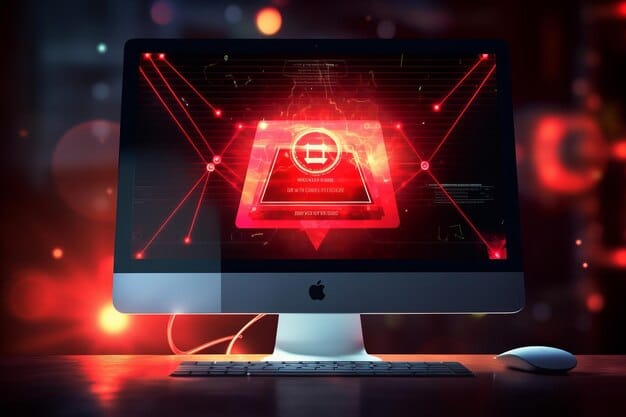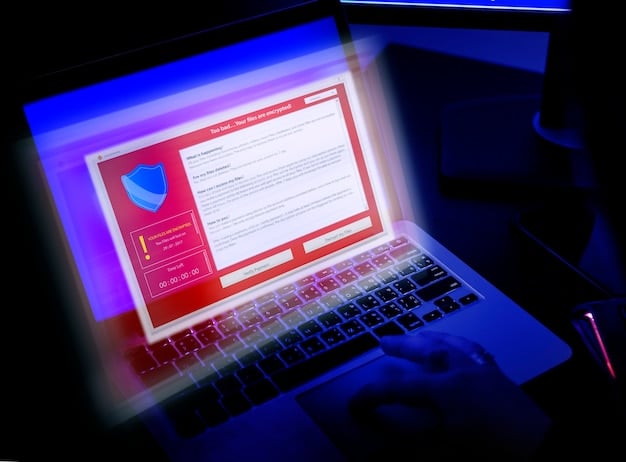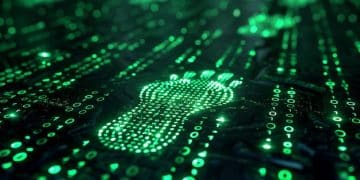Dark Web Data Risks: Protecting Your Personal Information Online

Navigating the dark web requires understanding the risks to your personal data and implementing strategies to minimize exposure, ensuring your digital privacy remains intact.
The anonymity of the dark web attracts both legitimate users and cybercriminals, creating a marketplace where personal data can be bought and sold. Understanding the risks associated with the dark web is crucial for protecting your digital identity. This article explores the dangers and provides actionable steps to minimize your exposure.
Understanding the Dark Web and Its Allure
The dark web, a hidden part of the internet, isn’t indexed by standard search engines. This makes it a haven for anonymity and a breeding ground for illicit activities.
It’s essential to differentiate the dark web from the surface web (what you access daily via Google) and the deep web (which includes content behind paywalls or requiring login credentials).
What Makes the Dark Web Attractive?
The dark web’s appeal stems from its promise of privacy and anonymity, achieved through networks like Tor (The Onion Router). Tor encrypts data and routes it through multiple servers, making it difficult to trace the user’s identity.
- Anonymity: Users can browse and communicate without revealing their IP address.
- Privacy: Transactions can be conducted using cryptocurrencies like Bitcoin, which offer a degree of anonymity.
- Accessibility: Despite its hidden nature, accessing the dark web is relatively straightforward with the right tools.
While these features attract whistleblowers, activists, and researchers, they also draw criminals engaging in illegal activities, including the sale of stolen data.
The dark web thrives on a culture of secrecy, making it challenging to monitor and regulate, thus exacerbating the risks to personal data.
The Risks to Your Personal Data
Once your personal data lands on the dark web, it can be used for various malicious purposes. From identity theft to financial fraud, the consequences can be devastating.
Understanding the types of data that are commonly traded and the potential impacts can help you take proactive measures.

Common Types of Data Sold
The types of personal data sold on the dark web are diverse, including:
- Financial Information: Credit card numbers, bank account details, and PayPal credentials.
- Personal Identification: Social Security numbers, driver’s license numbers, and passport details.
- Login Credentials: Email addresses, passwords for various online accounts, and usernames.
This information is often bundled and sold as “fullz,” or complete profiles, which include everything needed to impersonate someone.
Cybercriminals also trade in medical records, insurance information, and academic transcripts, which can be used for targeted scams or blackmail.
Data breaches at large companies are a common source of the data that ends up on the dark web. Stolen data is compiled and offered for sale to the highest bidder.
How Data Ends Up on the Dark Web
Several avenues lead to personal data appearing on the dark web. Understanding these pathways is critical for preventing data exposure.
Data breaches, phishing attacks, and malware infections are common culprits, each with distinct methods and consequences.
Common Pathways for Data Exposure
Your personal data can end up on the dark web through several ways:
- Data Breaches: Hacks that compromise large databases containing user information.
- Phishing Attacks: Deceptive emails or websites that trick individuals into revealing sensitive information.
- Malware Infections: Viruses and other malicious software that steal data from infected devices.
Data breaches are often the result of vulnerabilities in software or weak security practices by organizations.
Phishing attacks exploit human psychology, tricking users into clicking malicious links or downloading infected attachments.
Malware can be spread through infected websites, malicious advertisements, or compromised software installations.
Monitoring the Dark Web for Your Data
While preventing data from appearing on the dark web is ideal, it’s also important to monitor for your information to detect and mitigate potential damage.
Dark web monitoring services and tools can provide alerts if your personal information is found, allowing you to take swift action.
Tools and Services for Dark Web Monitoring
Several tools and services are available to help you monitor the dark web:
- Dark Web Monitoring Services: These services scan dark web marketplaces and forums for your email addresses, usernames, and other personal data.
- Identity Theft Protection Services: Many identity theft protection services include dark web monitoring as a core feature.
- Have I Been Pwned: A free website that allows you to check if your email address has been compromised in a data breach.
When choosing a dark web monitoring service, consider its reputation, features, and pricing.
Be sure to review the service’s privacy policy to understand how it handles your data and protects your privacy.
Timely alerts from these tools enable you to take action, such as changing passwords and monitoring your credit report.

Protecting Yourself: Minimizing the Risks
Taking proactive measures is the best way to minimize your risk of data exposure on the dark web. These measures include strong passwords, multi-factor authentication, and avoiding suspicious links.
Adopting a security-minded approach to your online activities can significantly reduce your vulnerability.
Essential Security Practices
Here are key security practices to implement:
- Use Strong, Unique Passwords: Create complex passwords that are difficult to guess and avoid reusing passwords across multiple accounts.
- Enable Multi-Factor Authentication (MFA): Add an extra layer of security to your accounts by requiring a second form of verification, such as a code sent to your phone.
- Be Wary of Phishing Attempts: Carefully examine emails and websites for suspicious links or requests for personal information.
Password managers can help you create and store strong, unique passwords.
MFA protects your accounts even if your password is compromised.
Regular security audits of your online accounts can help you identify and address vulnerabilities.
Besides these practices, keep your software up-to-date to patch security vulnerabilities. Use antivirus and anti-malware software to protect your devices from infections.
Responding to a Data Breach
If you discover that your data has been compromised in a breach, it’s important to take immediate action to mitigate the potential damage. Steps include changing passwords, monitoring credit reports, and placing fraud alerts.
Acting quickly and decisively can minimize the impact of a data breach on your personal and financial well-being.
Steps to Take After a Data Breach
Follow these steps if you suspect your data has been compromised:
- Change Your Passwords: Update your passwords for all affected accounts, choosing strong and unique passwords.
- Monitor Your Credit Report: Check your credit report regularly for any signs of fraudulent activity.
- Place a Fraud Alert: Contact one of the major credit bureaus to place a fraud alert on your credit file.
Consider freezing your credit to prevent new accounts from being opened in your name.
Report any fraudulent activity to your bank or credit card company.
Be prepared to provide documentation and cooperate with law enforcement if necessary.
Staying informed about data breaches and security threats can help you react quickly if your data is compromised.
| Key Point | Brief Description |
|---|---|
| 🔑 Dark Web Definition | Hidden part of the internet not indexed by standard search engines. |
| 🛡️ Data Protection | Use strong passwords and enable multi-factor authentication. |
| 🚨 Breach Response | Change passwords and monitor credit reports after a breach. |
| 🕵️ Monitoring Tools | Use dark web monitoring services to detect compromised data. |
Frequently Asked Questions
▼
The dark web is a hidden portion of the internet that is not indexed by standard search engines, requiring specific software like Tor to access. It is often associated with anonymity and illicit activities.
▼
Your data can end up on the dark web through various means such as data breaches, phishing attacks, malware infections, or even from unsecured databases that are illegally accessed.
▼
Common types of personal information found on the dark web include login credentials (usernames and passwords), financial information (credit card numbers), personal identification (SSNs, driver’s license details), and medical records.
▼
To protect yourself, use strong and unique passwords, enable multi-factor authentication, be cautious of phishing attempts, keep your software updated, and monitor your credit reports regularly for any suspicious activity.
▼
If you suspect your data is on the dark web, immediately change your passwords for all important accounts, monitor your credit reports, place a fraud alert on your credit file, and consider using dark web monitoring services.
Conclusion
Protecting your personal data from the risks of the dark web requires a proactive and security-conscious approach. By understanding the threats, implementing robust security practices, and staying informed, you can significantly reduce your vulnerability and safeguard your digital identity.





